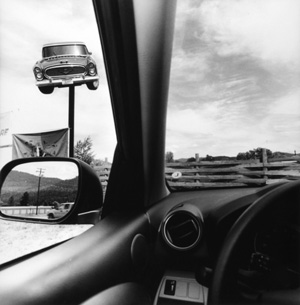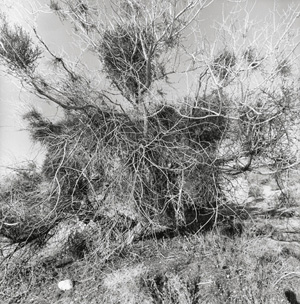Drive-by Shooting
John Haberin New York City
Lee Friedlander: America by Car and Recent Western Landscape
It sounds like a joke about the guy on vacation. He goes in search of America, but he forgets to get out of his car.
Lee Friedlander looks as if he might have trouble even if he wanted out. "America by Car" presents a dizzying portrait of a nation, not least because it looks so very familiar. Its gas stations, parking lots, and churches are a twenty-first century backyard. Its rocky heights became icons long ago. Friedlander photographs them all from the front seat, and by the show's end the car quite as much as America feels like home. 
Make that one home among many. Oh, how they multiply, and, oh, how he divides them. Often they put off even me. Together with a gallery exhibition of his recent landscape photography, all from 2008 and 2009, they show him at once on and off the road.
Tight spots and broken vistas
Lee Friedlander has worked in tight spaces before. "The American Monument" announced a project quite as grand as this one back in 1976, long before the American crossings of "But Still, It Turns" today. Its two hundred prints spoke to plenty of aspirations, sometimes up so close that one sees no more of a statue than its base. The namesake of Father Duffy Square stands hemmed in by a fence in front and the Times Square TKTS booth behind—while a skyscraper and its Coca-Cola sign block the avenue and tower over both. He later photographed a car from inside a phone booth. Now he does much the same in reverse, where Robert Adams in a fit of insomnia would surely have walked.
Well into his seventies, Friedlander is still going strong. "America by Car" includes almost two hundred more photographs, all from within the last fifteen years. If anything, his ambitions run farther, since his America now extends into Canada. He brings places together, and he brings them down to earth. He displays the pretend skyline in Las Vegas next to actual New York streets. And the street, even in the shadow of an elevated subway line, looks not just more genuine, but also more alive.
He finds cliff faces that Ansel Adams or Alfred Bierstadt might have made emblems of a nation. He finds gnarled trees that might have delighted Asher B. Durand or Frederick Law Olmsted. Only they, too, are places rather than god-given signs of man, nature, and a uniquely American destiny—for he finds almost identical ones thousands of miles apart. He designed the show itself to disperse and confuse attention. It packs everything into the Whitney's small fifth-floor mezzanine gallery, in two rows with frames almost touching. The focus of attention at one moment becomes a diagonal the next out of the corner of one's eye.
Oddly enough, the show feels manageable after all—and for much the same reasons. Not that Friedlander lacks for surprises and interest. Not that one forgets to linger over the details and puzzle out the vistas. Rather, one moves easily between shots until everything seems plain as day. It is a small world after all. In fact, it is the inside of a car.
Each photograph has that same dynamic—of multiplicity, confusion, confinement, and intimacy. Most obviously, the car itself fragments every scene. It is not a simple division between inside and out, like America for Danny Lyon or Gordon Parks. It is not formalist detachment or the pessimism of a nation apart. Instead the car's dashboard, roof, and frames twist and weave in and out of the picture. An entirely different landscape may seem to appear through the windshield and side window. Often as not, the side-view mirror crops the tidiest composition of all, like a wood-frame house out of Norman Rockwell, and one clings to it, even as the rest leaves one wondering.
One can see how MoMA pulled off a retrospective in 2005 with five hundred photos. Compared to Joel Sternfeld or Sally Mann, Friedlander makes a portrait of America as surfaces rather than secret histories, only the surfaces will not sit still. Naturally he has a fondness for signs, and they, too, are signs of passage. The dropped letter in a church's WELCOME becomes WE COME, and we come and go. He keeps returning to stop signs, but of course seen from a moving car. I became frightened when I remembered the camera and wondered who is driving.
Sivilize me
One had better remember the camera. When the photographer uses the window as a frame and the mirror as a reflection, he is insisting on another window, another frame, and another reflection. Even the sense of confinement alludes to the limits of representation. Maybe that is why Friedlander seems so alone. Except in portraits, the settings are devoid of people. The only other cars around him sit parked or on trailers. Exactly one image has the door open on the driver's side, and no one is getting in or out.
Once he does get out, and it puts the viewer that much more behind the camera and in the driver's seat. He stands, as irascible as in all his self-portraits, leaning forward over the car door. One can see his pose, like his expression, as friendly or aggressive. Regardless, the door creates one more barrier. And his black t-shirt reads Lee. The camera once again picks out a sign—and a sign of self-reflection.
All this makes Friedlander easy to respect but difficult to love or even to categorize, although the dream of America by car is still alive in photos by Joe Pflieger and Jeff Brouws. He refuses the "decisive moment," for a single, layered image contains any number of moments. He is not out to exalt the real America with Walker Evans, not when he literally takes statues off their pedestals. He does not have to resurrect America's folk art, like Evans with postcards, when each image is already a collage. He does not have to locate America beneath its tensions, like Robert Frank and Mark Steinmetz, for the everyday lies right in front of his eyes. Like Matthew Jensen by bus and Google Street View, he lacks even America's romance with automobiles and the open road.
With "Recent Western Landscape," he goes entirely off the road, and it can easily seem a departure. For years, he has looked at America trying to "sivilize" him, as Huck Finn complained. Even devoid of people, every landscape has been a human landscape, much as for Eleanor Ray today, and nature has long since given way to culture. This time, however, he looks at places about as inhospitable as they get—in Glen Canyon, Death Valley, and the Mojave Desert. Culture has set these places aside, and culture may insist that they, too, define America. But culture insists that they run wild.
Friedlander might be trying to break out of his image as a documentary or social—or maybe antisocial—photographer. For all that, however, he has much the same strategies as ever. In the gallery, he has simply shifted from monuments to national parks. He finds the great outdoors just as confining as highways, public squares, and the driver's seat. The undergrowth has made them all but impenetrable, both physically and to the eye. Again, too, he makes it difficult to assign them a subject.
Some of these places also appear in "America by Car," in the same nearly square format, and there are a lot of them. As usual, he has no decisive moment, only successive moments. He seems almost to refuse to make selections. Step back, and the sixty-five photographs fade into an all but identical gray. Up close, bushes and trees may bear tufts of snow or points of light, but the sky is neither cloudy nor clear. Just as in the city, space here is contested, but objects alone mark out space.
Closer than they appear
Those objects compete for attention. Not even the desert has much in the way of empty terrain. Three tall trees or a rockface, roughly parallel to the picture plane, may supply a focal point and a sense of symmetry. However, one has to see through one to get to the other. Meanwhile the rest of the landscape points and grows every which way, and who is to say what to call the real subject? What one took for the subject may be only a reflection in stagnant water anyway.
 Objects give the image an intricate texture, but also a forbidding one. They draw one in, even as they push one out. One clump of trees extends broadly outward, but also menacingly upward. Together, it resembles a comic-book villain, with a dark mask and outstretched cape. Not that Friedlander is scared or unhappy to see it. As in the comics, the villains have the most fun.
Objects give the image an intricate texture, but also a forbidding one. They draw one in, even as they push one out. One clump of trees extends broadly outward, but also menacingly upward. Together, it resembles a comic-book villain, with a dark mask and outstretched cape. Not that Friedlander is scared or unhappy to see it. As in the comics, the villains have the most fun.
Critics have called him formalist and antiformalist. They have spoken of his ability to compress a complex image into the picture plane, but the tension between two and three dimensions is palpable. They have called him Surrealist, but his tight spaces and careful compositions refuse hidden currents and fantasy. His assault on monuments parallels that of David Goldblatt or Jo Ratcliffe in South Africa, but he displays neither disdain nor an agenda. He shares something of the strangeness of Diane Arbus and Garry Winogrand—if not necessarily Winogrand's wide-angle lens. Yet he shows no overt signs of fragility, confrontation, or generational turmoil.
At the height of Modernism, literary critics spoke of "defamiliarization," but in order to find a constant freshness and a still point for contemplation. Friedlander's America does not sit still, and it does not seem terribly fresh. Modernism, too, spoke of the sanctity of the picture plane, but nothing here is sacred. After Postmodernism, the terms shifted to "deconstruction," and Jacques Derrida might have identified with the photographer's love of signs. That does not seem quite right either, though, given the plainness and shades of gray.
The subjects of "America by Car" really are familiar, like the drab titles of each photograph—mostly just a state or a city. If they tend toward New York and the American West, that, too, is no more or less than tradition. His portraits are especially casual. One figure just happens to come off like a toy atop the edge of the car door. Nothing out of the ordinary happens after all. The extraordinary just leaks out from the edges of the ordinary.
Several portraits include such artists and friends as Maya Lin and John Szarkowski, MoMA's long-time director of photography. They lean into the car, like Friedlander himself but with broader smiles. Szarkowski aligned Friedlander, Arbus, and Winogrand over thirty years ago in Mirrors and Windows: American Photography since 1960. They represented the windows—photographers who sought to see beyond themselves. Now America comes complete with side and rearview mirrors, and objects are closer than they appear.

Lee Friedlander's "America by Car" ran at The Whitney Museum of American Art through November 28, 2010, and his recent western landscapes at Mary Boone through October 23. A related review looks at Friedlander as "framed by Joel Coen."




